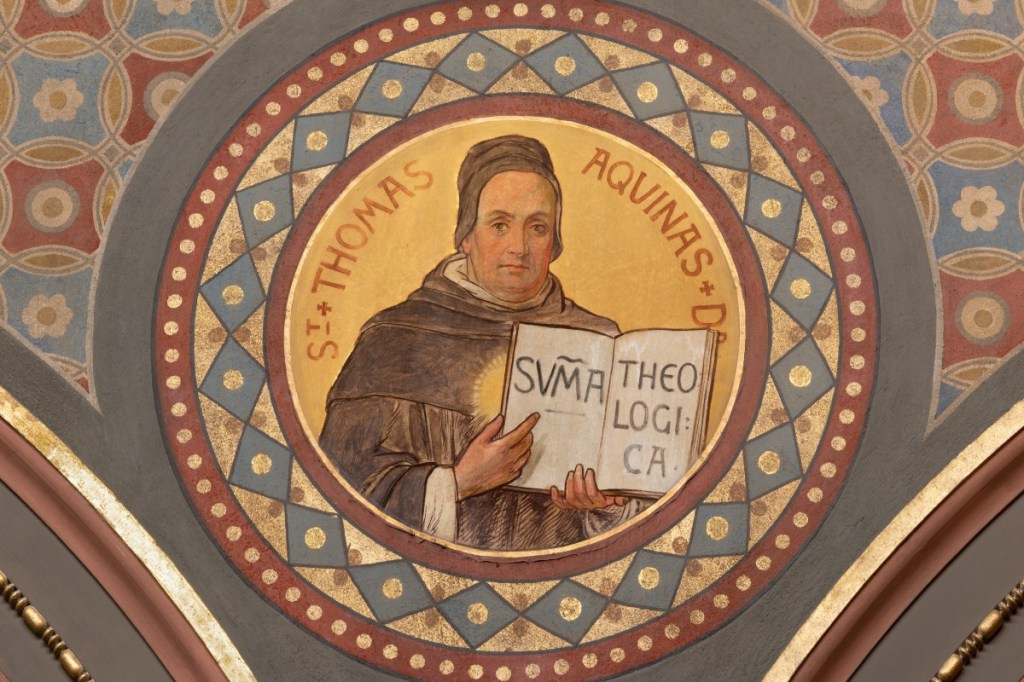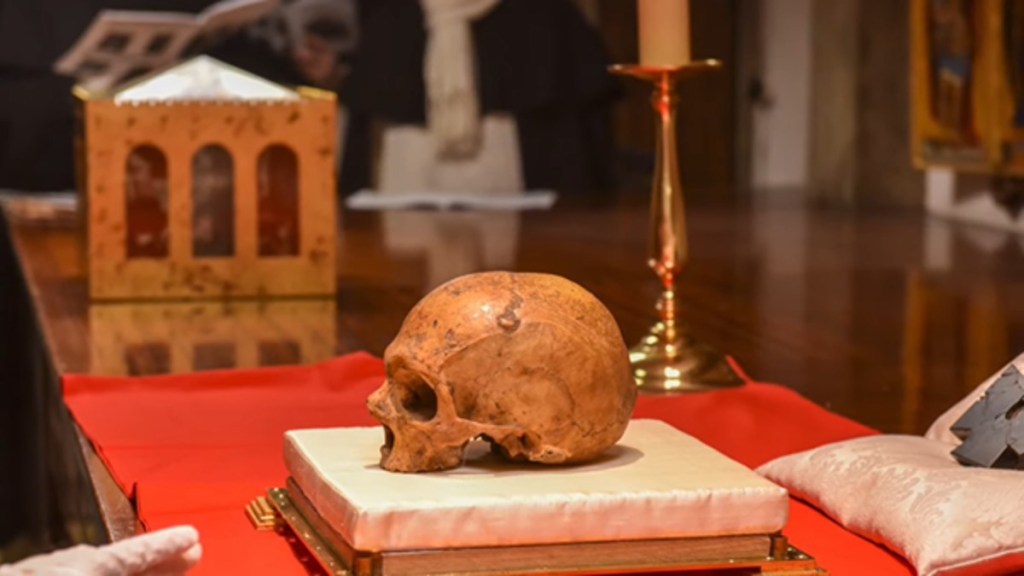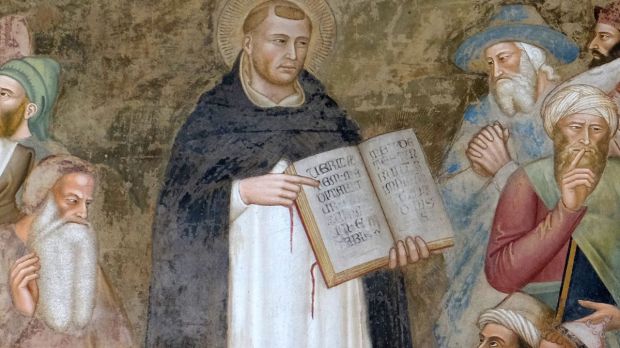From “dumb ox” to “Angelic Doctor.” Quite an evolution! Thomas Aquinas was born in Aquino, near Naples, in 1225, into a large Italian family. He was educated by the Dominicans and, at the age of 19, entered the novitiate of the Order of Preachers against the advice of his parents.
He continued his training in Paris, then in Cologne under Albert the Great. In Cologne, he was nicknamed the “dumb ox” by his peers for his imposing stature and taciturn character. He devoted his life to university teaching in France and Italy, and to writing his great work The Summa Theologica.
Thomas Aquinas was canonized by Pope John XXII on July 18, 1323, and proclaimed a Doctor of the Church by Pope Pius V in 1567. It was at this time that he received the title of “Angelic Doctor.”
The Summa Theologica
The Summa Theologica (also called the Summa Theologiae) is St. Thomas Aquinas’ greatest work. It is a theological and philosophical treatise that organically presents the whole of Christian doctrine.
A substantial work (in its full Latin text, it’s three times the size of the Bible!), it was originally intended for the instruction of young clerics, and for the ongoing formation of religious, priests, and lay people. Nevertheless, it remains accessible to the less “advanced,” as Saint Thomas emphasizes in the Prologue: “The teacher of Catholic truth must not only teach the more advanced, but also instruct the beginners, according to the words of the Apostle (1 Cor 3:1-2): ‘As to little children in Christ, I have given you milk to drink, not solid food.’ Our intention in this book, then, is to expound what concerns the Christian religion in the manner most suitable for the training of beginners.”

In answering 512 questions, Saint Thomas attempts to synthesize the faith and Christian wisdom as a whole. The Summa is divided into three parts: the first is devoted to the knowledge of God as both One and the Trinity of persons. The second, which is longer, describes man’s actions as a creature in the image of God. The third is about Christ and his life on earth, and the sacraments.
“Like straw” compared to his visions, but a light for Christian learning
Written during the last years of his life, at the height of his intellectual maturity, it represents seven years of work. It is unfinished because, after experiencing an ecstasy during Mass on December 6, 1273, Saint Thomas stopped writing. Everything he had written seemed to him “like straw” compared to what he had “seen.”
Unfinished though it was, the Summa Theologica had powerful influence throughout Europe and far beyond the Middle Ages. Six centuries later, in 1879, Pope Leo XIII declared that the writings of St. Thomas Aquinas adequately expressed the doctrine of the Church. In his encyclical Æterni Patris, he wrote: “the Fathers of Trent made it part of the order of conclave to lay upon the altar, together with sacred Scripture and the decrees of the supreme Pontiffs, the Summa of Thomas Aquinas, whence to seek counsel, reason, and inspiration.”
The Second Vatican Council explicitly recommended the study of his thought in two documents, the decree Optatam totius on formation for the priesthood, and the declaration Gravissimum educationis on Christian education.
The Angelic Doctor
In the 16th century, St Thomas was given the title of “Angelic Doctor.” Renowned for his purity (Leo XIII emphasized his “perfect integrity of morals”) and endowed with a luminous intelligence, St. Thomas was compared to an angel. In his motu proprio Doctoris Angelici, Pope Pius X refers to “the almost angelic quality of his intellect.”
But St. Thomas undoubtedly also owes this qualification to his profound reflection on angels. He was the first to define the angel as a purely immaterial, purely spiritual creature. He also developed a doctrine regarding guardian angels. For St. Thomas, guardian angels are faithful friends, personal guardians. At birth, every being receives a guardian. As long as they are pilgrims on earth, human beings, threatened by many dangers that come “from within and without,” are each assigned a special guardian: their “guardian angel” (Summa I, 113, 4).
Patron saint of Catholic schools
On August 4, 1880, Leo XIII declared St. Thomas the patron saint of Catholic schools. “The patronage of this great and holy man will be very powerful for the restoration of philosophical and theological studies, to the great advantage of society. For, as soon as Catholic schools are placed under the direction and tutelage of the Angelic Doctor, true science will easily flourish,” he writes in Cum hoc sit. This is why so many Catholic schools are placed under the protection of St. Thomas Aquinas.
Pope Pius X went even further, urging Italian philosophy teachers to teach the principles of Thomism. In his motu proprio Doctoris Angelici to encourage the study of the philosophy of St. Thomas Aquinas in Catholic schools, dated June 29, 1914, he exhorted: “The principles of philosophy laid down by St. Thomas Aquinas must be observed religiously and inviolably, for they are the means of acquiring a knowledge of creation most in keeping with the faith.” And he affirms: “We therefore want all professors of philosophy and sacred theology to be warned that if they deviate even one step, in metaphysics in particular, from Thomas Aquinas, they are exposing themselves to grave risks.”
Thomism
As its name suggests, Thomism is a school of thought directly inspired by the writings of Saint Thomas Aquinas. It consists of a form of philosophical realism. The originality of its thought lies in its reconciliation of the achievements of Aristotle’s thought with the demands of the Christian faith.
It highlights the coherence between faith and reason. “In an age when Christian thinkers were rediscovering the treasures of ancient philosophy, and more particularly of Aristotle, Thomas had the great merit of giving pride of place to the harmony which exists between faith and reason,” John Paul II emphasizes in Fides et ratio. “Both the light of reason and the light of faith come from God, he argued; hence there can be no contradiction between them.”
Over the centuries, Thomism has taken many forms, departing more or less from the initial reflections developed in the Summa Theologica. At the end of the 19th century, on the initiative of Pope Leo XIII, Thomism was renewed in a movement called neo-Thomism, whose most important representatives were Jacques Maritain and Étienne Gilson.
His relics
The body of St. Thomas Aquinas is preserved beneath the high altar in the church of the former Dominican convent in Toulouse, France. One of his relics, his skull, has been kept since 1369 in the convent of the Jacobins in Toulouse. In 2023, it was entrusted to the Dominicans of the Ville Rose for three years, in honor of the three jubilee years celebrating the 700th anniversary of his canonization (1323), the 750th anniversary of his death (1274) and the 800th anniversary of his birth (1225).

The head of Saint Thomas has already embarked on a series of visits throughout France, organized by the French Association for the Centennial of St. Thomas Aquinas (ACTA). By decree of Pope Francis, a plenary indulgence is granted to the faithful who venerate these relics.

